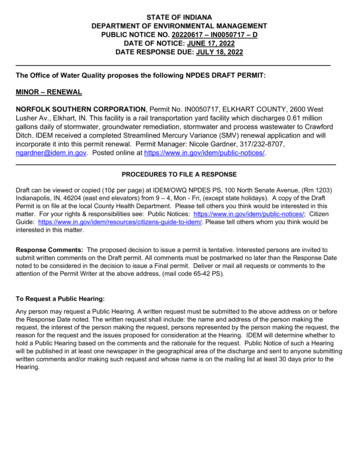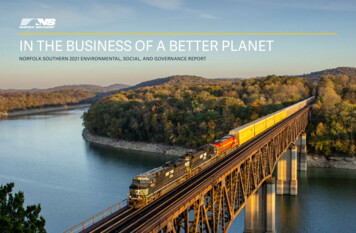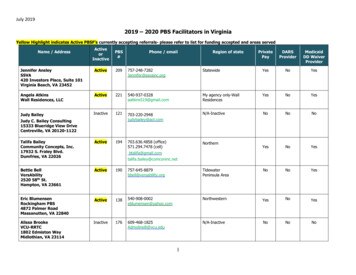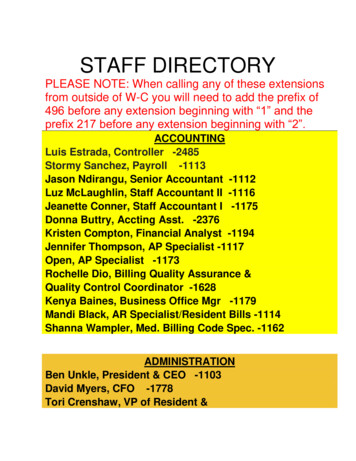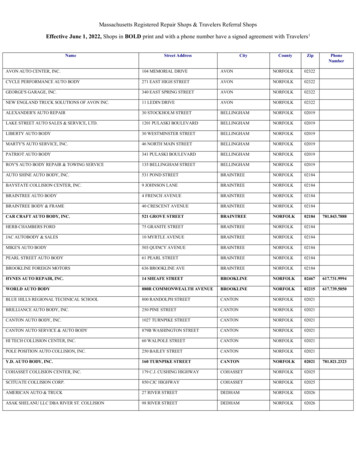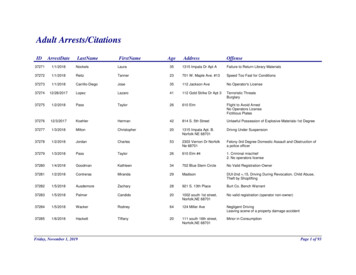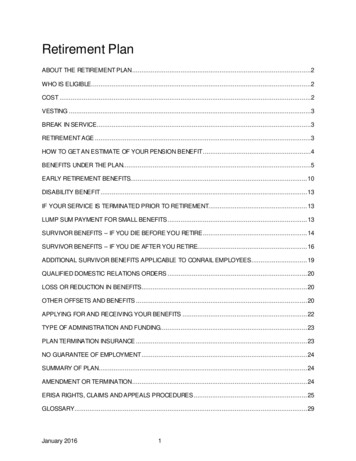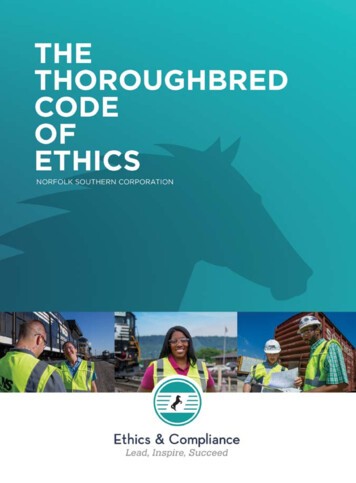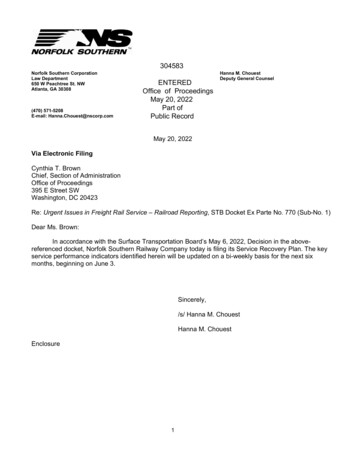
Transcription
NORFOLK SOUTHERNNorfolk Southern CorporationLaw Department650 W Peachtree St. NWAtlanta, GA 30308(470) 571-5208E-mail: Hanna.Chouest@nscorp.comTM304583ENTEREDOffice of ProceedingsMay 20, 2022Part ofPublic RecordHanna M. ChouestDeputy General CounselMay 20, 2022Via Electronic FilingCynthia T. BrownChief, Section of AdministrationOffice of Proceedings395 E Street SWWashington, DC 20423Re: Urgent Issues in Freight Rail Service – Railroad Reporting, STB Docket Ex Parte No. 770 (Sub-No. 1)Dear Ms. Brown:In accordance with the Surface Transportation Board’s May 6, 2022, Decision in the abovereferenced docket, Norfolk Southern Railway Company today is filing its Service Recovery Plan. The keyservice performance indicators identified herein will be updated on a bi-weekly basis for the next sixmonths, beginning on June 3.Sincerely,/s/ Hanna M. ChouestHanna M. ChouestEnclosure1
URGENT ISSUES IN FREIGHT RAIL SERVICE –RAILROAD REPORTINGSTB Docket No. EP 770 (Sub-No. 1)SERVICE RECOVERY PLAN FORNORFOLK SOUTHERN RAILWAY COMPANYMay 20, 2022Pursuant to the Surface Transportation Board’s (“STB” or “Board”) Orderdated May 6, 2022, Norfolk Southern Railway Company (“Norfolk Southern”) hasdeveloped the following Service Recovery Plan, in accordance with the guidanceestablished by the Board. Norfolk Southern understands the essential role we playin supporting our customers’ businesses and the national economy. NorfolkSouthern’s mission is to provide an efficient, reliable transportation service, and werecognize that our current service levels do not meet the expectations of ourcustomers, the Board, or ourselves. We are highly motivated to restore the level ofour service and handle higher volumes. Recovering our service is Norfolk Southern’shighest priority.Norfolk Southern has taken significant action to improve our service throughaggressive hiring practices and, as we noted in our April testimony, recentlyannounced the development of a new operating plan, TOP SPG, which willcontribute to enhanced efficiency and improved service for our customers. “SPG”stands for “Service, Productivity, and Growth,” which is the direct focus of NorfolkSouthern: improving service for our customers, enhancing our productivity, andgrowing our business. Norfolk Southern is laser focused on these goals and isconfident in its ability to improve service and deliver a customer-centric railproduct.In accordance with the Board’s order, Norfolk Southern has identified four (4)key service performance indicators to inform its service recovery:1.2.3.4.System VelocityTerminal DwellLocal Operating Plan AdherenceOn Time DeliveryTogether, Norfolk Southern believes that these four key service performanceindicators, as well as Norfolk Southern’s progress toward increasing its qualifiedTrain and Engine (T&E) headcount, provide an accurate snapshot to the Board andto our customers of the overall health of the Norfolk Southern network and ourprogress toward service recovery. In particular, metrics regarding system velocity1
and terminal dwell have been reported to the Board for a number of years in docketEx Parte 724, Sub-No. 4. Norfolk Southern believes these publicly reported metricsprovide meaningful information to the Board and the public regarding the overallhealth of the Norfolk Southern system. Below, Norfolk Southern providesadditional detail regarding each of the four key service performance indicators andits T&E hiring progress.In its Order, the Board has requested a target of where Norfolk Southernexpects the metric to be in six months for each of the key service performanceindicators. Any target offered for these four key service performance indicators willbe informed by Norfolk Southern’s progress in its hiring efforts, which NorfolkSouthern describes in more detail below. Norfolk Southern’s goal is to restoreservice to 2019 levels. It is uncertain whether Norfolk Southern will achieve thatgoal within six months. At the outset, Norfolk Southern notes that each of these keyservice performance indicators is impacted by a multitude of factors, which makeany ‘target’ or ‘forecast’ speculative at best. These metrics are dependent on manyfactors outside of Norfolk Southern’s control including, but not limited to: marketdemand, customer action, weather events, unanticipated track outages, andnational health emergencies. With the implementation of TOP SPG, NorfolkSouthern expects that operations and train productivity will change and will impactthe key service performance indicators and any targets reported herein.1) SYSTEM VELOCITYSystem Velocity—or train speed—is an indicator of the overall fluidity andhealth of the Norfolk Southern network. It represents average road train speed overthe network. In general, a higher System Velocity indicates a faster, more fluid railnetwork. Weekly System Average Train Speed is a familiar metric to the Board andthe public, as the Board already receives this on a weekly basis pursuant to thedata submitted in the Docket No. Ex Parte 724 (Sub-No. 4).System Velocity as reported in this Service Recovery Plan will be the same asthe Weekly System Average Train Speed metric reported in Docket Ex Parte 724(Sub-No. 4) for the respective reporting week. Accordingly, the same methodologywill be used in both dockets. 1As it pertains to System Velocity, in its Order, the Board requested that thecarriers “report on any plans it has to lift current velocity restrictions, as well asany plans it has to increase the power on its through trains ”. Order at 5. NorfolkSouthern does not have a system-wide velocity restriction. The speed of a particulartrain is determined by a myriad of factors, which include track speed limits,See Norfolk Southern Methodology, Docket No. EP 724 (Sub-No. 4) at 2, available ta/ (“Data Methodologies”)12
geography, train mix, track occupancy, and efficiency and energy managementconsiderations, among others. Those factors similarly inform power usage on eachtrain. Norfolk Southern does utilize energy efficiency management systems, whichimprove fuel efficiency and limit emissions caused by rail transportation. Wheretrains are not meeting expected schedules, Norfolk Southern has relaxed certainenergy management tools and Norfolk Southern will continue to do so whereappropriate and where it would have a positive impact on network fluidity.For the week ending May 13, 2022, Norfolk Southern’s weekly systemaverage train speed was 17.34 MPH. Norfolk Southern’s goal is to achieve a systemaverage train speed in the range of 21.5 to 23.1 MPH, which would equate toaverage quarterly train speeds in 2019. It is uncertain whether Norfolk Southernwill achieve that goal within six months.2) TERMINAL DWELLTerminal Dwell, similar to System Velocity, is an overall network metric thatprovides a snapshot of the fluidity at Norfolk Southern terminals and indicates howlong, on average, a car dwells at a terminal during transit. As our Chief OperatingOfficer, Cindy Sanborn, testified at the Service Hearing on April 26, 2022, trafficfluidity at rail terminals supports broader service improvement and productivityacross the network. Improvements to fluidity at terminals has a ripple effect andproduces a direct benefit to the network as a whole. Accordingly, it is a helpfulmetric for evaluating service recovery.Like System Velocity, Terminal Dwell is also already reported to the Board inthe Ex Parte 724 (Sub-No. 4) docket on a weekly basis for the average of the overallsystem and for the 10 largest terminals on the Norfolk Southern network. Inaccordance with the Board’s order in this docket, Norfolk Southern will be includingthe next largest terminals—terminals 11–20—in its temporary weekly reportingusing the same methodology used in the Ex Parte 724 (Sub-No. 4) docket, with theexception that it will pull the added terminals as required by the Board. 2Together, System Velocity and Terminal Dwell offer a snapshot of the overallhealth of the network and are used by Norfolk Southern personnel to evaluate ourprogress toward service recovery.For the week ending May 13, 2022, Norfolk Southern’s average systemterminal dwell was 28.1 hours. Norfolk Southern’s goal is to achieve an averagesystem terminal dwell in the range of 18.1 to 22.4 hours, which would equate to theaverage quarterly system terminal dwell in 2019. It is uncertain whether NorfolkSouthern will achieve that goal within six months.2Id.3
3) LOCAL OPERATING PLAN ADHERENCEIn its Order, the Board required that carriers include in their ServiceRecovery Plan an indicator and target for First Mile-Last Mile service. NorfolkSouthern uses Local Operating Plan Adherence (“LOPA”) as a measure of itssuccess in delivering cars to a customer’s local facility upon order from the localserving yard.LOPA measures compliance of scheduled placements and pulls at a customerfacility at a railcar-level, or stated differently, the percentage of time that NorfolkSouthern successfully adheres to the Industrial Work Order (IWO) for a particularlocation. An IWO is populated based upon the orders placed by customers for serviceon that date. For each assigned crew, cars are scheduled to be pulled and placedsystematically on an IWO, which is generated at the beginning of the respectivecrew’s on-duty time. For open gate customers, the IWO will include the specific carsrequested for delivery on that date. For closed gate customers, all cars available forplacement in the yard will populate on the IWO as having been ordered by thecustomer. The IWO also includes cars scheduled to be pulled from customerfacilities—including loads and empties. A planned placement or pull is measured ascompliant when the railcar is placed or pulled within 12 hours of the IWO creation.LOPA failures can be both railroad-caused and non-railroad caused. TheLOPA figure reported in this Service Recovery Plan will count both railroad-causedand non-railroad caused missed service as a failure which will count against theLOPA indicator.For the week ending May 13, 2022, Norfolk Southern’s system average LOPAwas 74%. Norfolk Southern’s goal is to achieve a system average LOPA in the rangeof 75.5% to 83.3%, which would equate to the system quarterly average LOPA in2019. It is uncertain whether Norfolk Southern will achieve that goal within sixmonths.4) ON TIME DELIVERYIn its Order, the Board required that carriers include in their ServiceRecovery Plan an indicator and target for Trip Plan Compliance, and morespecifically the percentage of cars constructively or actually placed at destinationwithin 24 hours of the original estimated time of arrival. Norfolk Southernrecognizes that for many customers, an important indicator of rail service iswhether they receive their freight when expected. Accordingly, Norfolk Southernmeasures its manifest service performance based upon its adherence to itsscheduled train service.4
For scheduled manifest train service, Norfolk Southern generates an OriginalExpected Time of Arrival (“Original ETA”) following the first car handling event onthe Norfolk Southern network at a car level. The Original ETA is made available tocustomers via the AccessNS platform. Norfolk Southern uses the Original ETA tomeasure, among other things, whether the car arrives on time, early, or late, at thecustomer facility. The measure provided in this Service Recovery Plan will indicatethe percentage of cars that are constructively or actually placed at destinationwithin 24 hours of the Original ETA. 3For the week ending May 13, 2022, Norfolk Southern’s weekly percentage ofmanifest service rail cars placed within 24 hours of the Original ETA was 48%.Norfolk Southern’s goal is to achieve an average weekly on time delivery in therange of 74.9% to 87%, which would equate to the system quarterly average on timedelivery in 2019. It is uncertain whether Norfolk Southern will achieve that goalwithin six months.TRAIN & ENGINE HEADCOUNTEssential to our service recovery is having the right number of T&Eemployees at the right location at the right time to meet the demand. As wasdiscussed at the April service hearings, the pandemic altered the labor market inprofound and unexpected ways, not only in the transportation industry but in allsectors of the economy. Norfolk Southern did not experience a mass exodussystemwide. In fact, the overall turnover rate for qualified T&E employees hasremained relatively steady over the past three years. However, Norfolk Southernexperienced significantly higher turnover in certain key locations. That turnover,compounded by the challenge of hiring significant numbers quickly in an extremelytight labor market, has led to meaningful workforce shortfalls on critical portions ofour network. The stress experienced in certain key areas created collateral impactsin other parts of the network which further strained our resources.To forecast the staffing needs of the network, Norfolk Southern relies uponcustomer inputs and predictive analytics, recognizing that even a streamlinedprocess for recruiting and training new conductors takes several months.Forecasting needs for T&E employees is particularly challenging since theseemployees cannot easily be deployed to different locations. Norfolk Southern’s T&Etotal workforce is fundamentally derived from a collection of 95 distinct groups ofassignments within certain geographic boundaries which limits our flexibility in33Cars that arrive prior to the Original ETA are considered to be on time.5
how to deploy our employees. Norfolk Southern’s hiring goals include sufficientstaffing to handle peak budgeted volume with adverse seasonable availability.To onboard as many new Conductors as possible, as quickly as possible,Norfolk Southern added significant resources to our Talent Acquisition, HealthServices, and Technical Training teams to handle the higher volumes of jobapplicants and conductor trainees. We have streamlined the hiring and onboardingprocess, reducing the number weeks from identifying candidates to thecommencement of training. It takes trainees on average about 4 months tocomplete the rigorous training program, although it takes longer in some locationsthan others depending on the complexity of the territory. Employees who completetraining can demonstrate that they are able to safely perform the work and qualifyas Conductors.Norfolk Southern has been starting new classes of Conductors every weekthis year and expects to continue at that rate through the first half of the year. Tohandle that volume, Norfolk Southern is training on two shifts at our technicaltraining center in McDonough, GA. To support those efforts, we employed 35additional full-time and contract trainers and are leveraging former conductors andengineers who are currently in other roles in the company. Over 20 of thoseemployees volunteered to spend two weeks as “adjunct instructors” who can supportthe full-time staff—for example by coaching trainees on tasks such as properlymounting and dismounting equipment, throwing switches, lacing air hoses, andchanging knuckles.As of May 16, 2022, Norfolk Southern had 930 Conductor Trainees on ourproperty and we expect our qualified T&E headcount to grow sequentiallythroughout the year.In planning and forecasting for future labor needs, Norfolk Southern istaking into account evolving labor market conditions. Norfolk Southern recognizesthat the pandemic has caused people to reconsider the role of work in their lives.The labor force participation rate has still not recovered and for those who areworking, priorities around work/life balance have changed. They are placing morevalue on spending time with family and having a predictable work schedule isincreasingly important.Today, Conductors can have unpredictable schedules and may be required tospend many nights away from home. Norfolk Southern welcomes opportunities tothink creatively about how careers at our company can make positions at therailroad more attractive, and in particular more predictable, in this competitivelabor market.In the meantime, initiatives with Norfolk Southern’s current workforceinclude availability bonuses, retirement deferral incentives, and vacation buy backs.We have grown the ranks of our “go teams” and reprioritized their deployment tothe areas of our network experiencing the most critical need. We have also offered6
temporary transfer incentives to help address localized needs for months at a time,as well as permanent transfer incentives. These targeted, localized approaches giveNorfolk Southern more flexibility to respond to strained segments of our network.Norfolk Southern expects to continue to grow our ranks throughout the nextsix months and will continue to report to the Board our progress in that regard.7
health of the network and are used by Norfolk Southern personnel to evaluate our progress toward service recovery. For the week ending May 13, 2022, Norfolk Southern's average system terminal dwell was 28.1 hours. Norfolk Southern's goal is to achieve an average system terminal dwell in the range of 18.1 to 22.4 hours, which would equate to the

